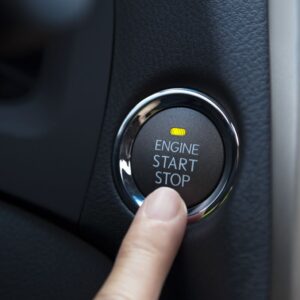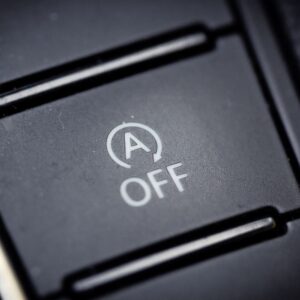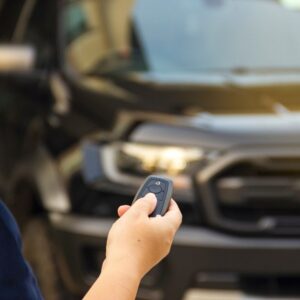The push to start button is an increasingly common feature in newer car models. Also called the engine start button, it lets you start and turn off the engine in a vehicle with keyless ignition or push-button ignition. Because of the button’s convenient location and ease of use, you might have wondered what might happen if you accidentally pushed it while driving your car.
Will your car continue moving? Will it stop? How fast will it decelerate? Will anything else happen? Since pressing the push to start button can potentially affect your safety on the road, it’s a good idea to find out if doing this might cause issues.
Can You Stop Your Moving Car with the Push To Start Button?
Fortunately, you don’t have to personally find out what happens when you press the push to start button while driving your car. Professionals tried this on empty roads. They drove their vehicles at different speeds and recorded what happened when they deliberately pressed the push-button start. The effect varied according to how fast the car was going at the time.
Very Low Speeds
If the car travels at a low speed, it will turn off its engine if you press the push to start button. Thankfully, the slow movement makes it easier to retain control of the vehicle.
Some models with keyless ignition will turn off their engine when you use the push to start button while moving at five miles per hour or at a similarly slow speed. It’s a safety feature that helps prevent accidents.
Medium Speeds
Keyless ignition-equipped cars moving at higher speeds will generally keep moving even if you accidentally press the push to start button.
However, if you hold the push to start button down, you can turn off the engine even when the car’s moving at moderate speeds. You might even have to deliberately do this during an emergency, although you should only do so as a last resort. There are better ways to stop your vehicle than mashing the push to start button.
Highway Speeds
Highways require you to maintain high speeds. So, what happens if your finger lands on the push to start button by mistake while cruising on highways?
Thankfully, nothing will happen. Your car will continue going down the highway without slowing down. Its engine will continue running.
Much like what they do at medium speeds, vehicles with keyless ignition will keep running at higher speeds despite the push to start button getting pressed. Furthermore, they will warn you that they won’t shut down their engine while moving at high speed.
While accidentally pressing the push to start button while driving your car will usually cause no problems, avoid doing it as much as possible. There’s a low but non-zero chance that essential systems like power steering and power brakes might turn off if you push the button. If you lose those systems without warning, you might soon lose control of your car and end up in an accident.

Try These to Stop Your Push Button Ignition Car
Imagine the following scenario: You’re driving on the road when your car abruptly starts acting up. Perhaps it accelerates without warning and outside your control. You must halt your runaway vehicle as quickly as possible.
In such an emergency, you might think to use the push-to-start button to turn off the engine and stop your car. However, resist pressing it immediately. There are safer and more effective ways to stop your vehicle that you must try before resorting to the button.
Put Your Car in Neutral
The first thing you should try is to shift gears to neutral. It decouples the wheels from the engine. Without the power transmitted from the engines, the wheels won’t spin for long.
Putting your keyless ignition-equipped car in neutral is the simplest and easiest approach to stopping the vehicle during uncontrollable acceleration. You can do it in both manual and automatic cars.
Gently Apply the Brakes
Does your car continue to move after you shift to neutral gear? Slowly apply light pressure on the brake pedal. Without the power transmitted from the engines, the drive wheels will stop when you engage the brakes. Avoid hitting the brakes hard to reduce the risk of accidentally locking them, although an anti-lock braking system usually minimizes that issue.
Release the Gas Pedal
Are you driving an older model with a keyless ignition? If your car’s throttle gets stuck in the open position, release the gas pedal to close the throttle valve.
Raise your foot from the throttle pedal. Without the pressure applied by your foot, the pedal will return to its standard position. The throttle should close.
If you drive a newer model, you can skip this step.
Finally, Press the Push to Start Button
Even if the previous steps fail to stop your car, they usually reduce its speed to something slower and safer. They make the last resort more effective.
Now you can press the push to start button, which turns the engine off if you’re going slow enough. Without the power from the engine to drive its wheels, your car will eventually stop moving.
Other Tips
If your car has an automatic transmission, avoid shifting gears to parking after turning off the engine. Instead, keep it neutral.
Some cars with push to start buttons also come with an ignition key. You can shut down the engine by turning the key.
Warn Other Drivers
You’re not the only one on the road. Other drivers are usually also present, and pedestrians might be crossing the road. You want to avoid any accidents while trying to stop your car.
Inform other drivers about your predicament by flashing your car’s hazard lights and using the car horn. While the sudden light show and honking might annoy them, they’ll appreciate the heads-up about the potential danger.
Like any other feature, use the push to start button properly. Only use it to start the engine while your car isn’t moving. Avoid using it to stop your vehicle, even in an emergency. If you must use it, follow the recommended procedure to ensure you successfully stop your car.
Dangers of Push to Start Button
While the feature is convenient, forgetting to turn off the engine in a vehicle with push button ignition comes with risks. These include carbon monoxide buildup, vehicle damage, physical injury, and higher chances of theft.
Carbon Monoxide Buildup
Some newer vehicle models have noiseless engines, making it easy to forget you switched off the engine when using a keyless ignition system. This can be dangerous, as carbon monoxide may build up and even seep into your home.
More than 30 people have died from carbon monoxide poisoning since keyless-ignition vehicles became available in 2006.
Vehicle Damage and Physical Injury
Similarly, forgetting to turn off the car and shifting the gear to “Park” may cause it to roll and crash. In the worst-case scenario, your vehicle may cause injury to pedestrians.
Increased Risk of Theft
Push-to-start buttons are easier to hack than traditional car keys, making your vehicle more prone to theft. Some thieves use artificial intelligence systems to pick the signal from the key fob and start the car.
Where to Get a Good Roadside Emergency Kit
If you ever have to make an emergency stop, you’ll want a good roadside emergency kit in your vehicle. These kits help you alert other vehicles on the road that you can’t move your vehicle and are waiting for a tow service or other aid. If you need a new roadside emergency kit, or one that has more accessories, why not check the ones on CarParts.com?
CarParts.com has a number of different roadside emergency kits in our online catalog. Some kits even include jumper cables to kick-start your engine when the push-button isn’t working. It’s easy to navigate the site, and placing your order only takes a few quick clicks. Checking out is also secure and convenient once you pick a kit that suits your needs. Your order should arrive in as few as two business days if you order before 12pm ET.
Don’t be caught unprepared. Purchase a Roadside Emergency Kit for your vehicle from CarParts.com now.
Any information provided on this Website is for informational purposes only and is not intended to replace consultation with a professional mechanic. The accuracy and timeliness of the information may change from the time of publication.














